Matador Network's Blog, page 715
January 15, 2021
US airlines ban guns in checked bags

To prevent any potential violence in Washington DC next week during the presidential inauguration, several major airlines are temporarily banning guns in checked baggage on flights headed to DC, the Associated Press reports.
Usually firearms are permitted in checked bags as long as they’re not loaded and locked in a hard-sided container. Now, however, Delta, United, Alaska, Southwest, and American Airlines are all banning guns from Saturday through at least January 23.
Airlines are on high alert after the riots that took place at the US Capitol on January 6, and they’re stepping up their security measures.
American Airlines will not serve alcohol on flights to and from the Washington area from Saturday to next Thursday. The airline will also add security staff in the DC area airports.
Earlier this week, the Federal Aviation Administration also promised to crack down on passenger behavior with serious penalties, including $35,000 fines and jail sentences. The Federal Aviation Administration explains that in the wake of the Capitol riots, there have been a growing number of violent incidents in the DC area involving unruly passengers. 
The post Major US airlines ban guns in baggage for Washington DC flights appeared first on Matador Network.

Black travel in 2021
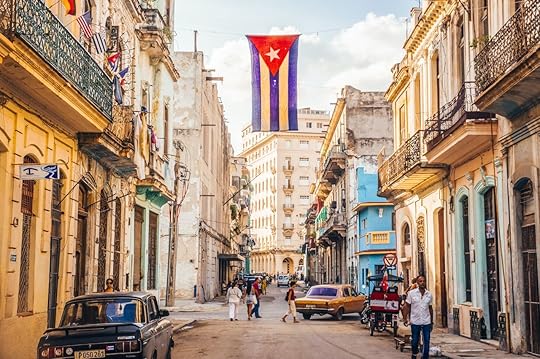
The travel industry was dealt an immeasurable blow in 2020; with planes grounded and travel posing a real threat to containing the coronavirus, nonessential travel, even for those who travel frequently or full-time, became dangerous, irresponsible, and, in some places, impossible. But now, with vaccines starting to roll out in several countries, we are collectively beginning to entertain a return to “normal,” including a return to travel, in 2021.
But for people in the Black diaspora, what was “normal” before the outbreak isn’t something we’re excited, or willing, to return to. The pandemic exacerbated the symptoms of the inequities we already face in our day-to-day lives, and many full-scale revolutions erupted around the world.
And I know, y’all. We all love Tulum, which became a Black travel hotspot in 2020 due to Mexico’s rather lax restrictions surrounding travel to the nation during the pandemic. But coming into 2021, I urge you to reevaluate exactly why we travel and choose your destinations accordingly.
If 2020 forced us to align our choices more closely with our moral compasses, to support movements and companies and services that will fight with us for our liberation, then 2021 will be the year we will gain the opportunity to behave accordingly with our travels.
There are tangible, actionable ways to do this.
We can divest from travel companies that have remained silent on the Black revolution and recognize that this signals their complicity in white supremacy. We can educate ourselves on the history and legacy of colonialism and how it affects Black lives, and reject how white hegemony uses travel as a form of neo-colonialism to this day. And maybe most importantly to this list, we can spend our travel dollars supporting Black communities, and the communities of our allies, worldwide.
While before we traveled for the what — the perfect beach, the perfect tour, the perfect food – it’s time we start considering the why, and centering our travels around connecting with people from what we are told are disparate communities. It’s time to ally ourselves with the folks who stand with us in solidarity and to find common ground from which we can continue to build. Because after a year so many of us were forced to spend in isolation, 2021 should be the year we come together.
1. Reykjavik, Iceland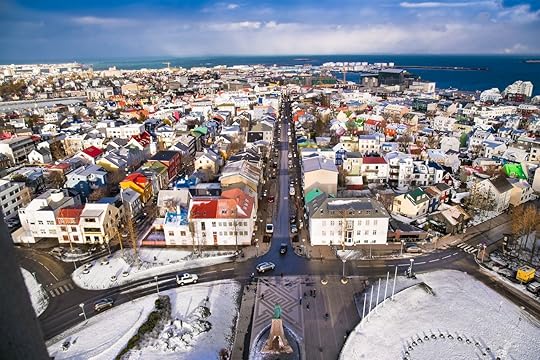
Photo: Aleksandar Todorovic/Shutterstock
A relatively tiny island nation crossing the Arctic Circle in the North Atlantic, Iceland needs no introduction when it comes to its spectacular fjords, epic volcanoes and glaciers, and inviting thermal hot springs. But despite its massive worldwide popularity for travelers, Iceland has a reputation for being extremely homogeneous, which can leave Black travelers and transplants to the nation wary, worried about how they might be received. Enter Jewells Chambers, an Iceland resident by way of the United States and founder of All Things Iceland, a collection of interconnected media platforms she created to educate visitors, particularly those of color. Between her Instagram page, podcast, and her following on YouTube, she inspires Black people around the diaspora to give Iceland a try.
Chambers recently conducted a nearly hour-long interview with Miss Universe Iceland 2019, Birta Abiba Þórhallsdóttir, who is of Icelandic and Congolese descent. She went into intense detail on her experiences being raised in Iceland, describing the racism she has faced and her journey to embrace self-love as a form of healing. In the Interview, Birta details her year traveling around the world acting as the face — the Black face — of a country often thought of as exclusively white. Both Birta and Chambers are here to change that perception by showing their followings that not only do people of color move to Iceland, but they’re also born there.
While Chambers maintains infectious energy and undeniable optimism, she’s not naive to the fact that racism exists in Iceland. Her straightforward and to the point exposition on the state of racism there removes the fear it may normally inspire. “People of color, of different shades, have been discriminated against [here,]” Chambers expounds in a 2018 video. “We need, in general, to band together.” The community Chambers has built online now exists as a rallying cry for Black travelers, a beacon that reminds folks to reclaim their space. I encourage you to join her.
If you check out her video “7 Stunning Places in Iceland I Visited in 2020,” you’ll get a glimpse into what Chambers considers her favorite places in the small nation, and renting a car in Reykjavik will give you the freedom to follow in her footsteps. You could check out the alluring GeoSea Baths which Chambers recommends as an alternative to the super touristy Blue Lagoon, or you could “journey to the center of the earth” by literally climbing inside a dormant volcano.
2. Marrakech, Morocco
Photo: Balate Dorin/Shutterstock
Creatives have long flocked to Morocco; we’ve seen many famous examples, particularly writers, who have found inspiration in the ancient city, including William S. Burroughs, George Orwell, and Jack Kerouac. But a new school of creatives is flocking to the North African nation, and they are decidedly more melanated.
Multicultural and multiethnic by design, Marrakech has a knack for making folks who hail from many parts of the world feel right at home. It has been a hub for trade and the host of international craftspeople and artisans for hundreds of years, and it owes this to the clear influences of Sub-Saharan Africa, Europe, and Asia. This combination of cultures and long-held entrepreneurial spirit are just a couple of reasons that Black expats are choosing the storied city over, say, Paris, which has historically attracted the Black creative elite.
One of the champions of this movement is a designer, entrepreneur, and titan of Moroccan hospitality as the owner of the legendary villa Jnane Tamsna, Meryanne Loum-Martín, who is a longtime resident of Marrakesh by way of the French capital. In addition to her new lifestyle brand and photography book, 2020 was also the year she launched AFREE Culture, a salon event for culturists, creatives, and entrepreneurs that will be returning late next summer.
Loum-Martín hopes it will become just one of many touchstones to aid in celebrating “African Creativity and International Black Excellence through curated events focused on film and literature,” though unlike her other entrepreneurial endeavors, she sees it less like something to capitalize on and more like a true convening of creative thought. When asked what her best investment has been over the years, she answered, “Letting myself go with my instinct about Marrakech 30 years ago and discovering that it was the right place for me.” Maybe Marrakech can be right for you, too.
3. Ho Chi Minh City, Vietnam
Photo: John Nguyen263/Shutterstock
A particularly arresting scene in Spike Lee’s incredible 2020 film Da Five Bloods is a monologue delivered brilliantly by Ngo Thanh Van as the very real Hanoi Hannah. “Black GIs,” she recites into the microphone, “nothing is more confused than to be ordered into a war to die without the faintest idea what’s going on.” Long understood to be a mere pundit of North Vietnamese propaganda, our contemporary understanding of the United States’ role in Vietnam makes Hanoi Hannah seem less a tactic of manipulation on the part of the opposition and more of a figure of solidarity with the very real American soldiers sent overseas, particularly for Black GIs who were possibly the most disenfranchised among them.
For many, Da Five Bloods was the first piece of media to recontextualize American involvement in the war in Vietnam, some shifting their preexisting concepts of victim and villain and inciting a newfound interest throughout the Black diaspora of visiting the country. Huge portions of the film were set and shot in Saigon, now Ho Chi Minh City, so it’s a perfect place to begin your journey. While a visit to Ho Chi Minh City includes re-educating yourself on the history of the Vietnam War, consider it a lesson that can help teach you to remain more critical of world powers going forward. Let this be the lesson that instills within you the fact that no regime is above examination.
Let your re-education begin at the Củ Chi tunnels. There you can see first hand the conditions from which the Viet Cong launched the Tết Offensive. They are preserved by the Vietnamese government as a memorial to the war, and in some of the safer sections of the underground complex, tourists are invited to go within them, underground. But no site is likely more jarring than the War Remnants Museum, originally opened in 1975 to highlight American war crimes in Vietnam. The exhibits contain a mix of military artifacts, curiosities, and photographic installations including a massive and arresting display in remembrance of the My Lai Massacre, wherein American soldiers decimated as many as 500 unarmed civilians in Sơn Tịnh District in March of 1968. If you’d like to book a tour, you can arrange one through the museum that also includes visits to The Reunification Palace, Giac Lam Pagoda, and the famed Ben Thanh Market.
4. Havana, Cuba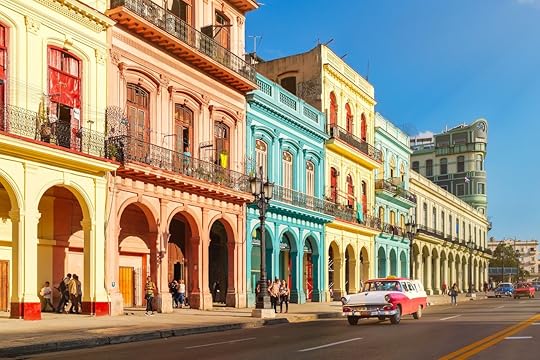
Photo: Kamira/Shutterstock
On November 9, 2020, Afro-Cuban rapper and pro-democracy activist Denis Solís González filmed a police officer who had entered his house without a warrant and posted it to his social media. For this, he was arrested on the charge of contempt and sentenced, without council, to eight months in prison. Following his detention, Havana erupted into days of civil unrest with Cuban creatives of all stripes spearheading the actions. Like other civil rights movements of 2020, these actions mark a new refusal to accept the treatment of Cubans — and particularly Afro Cubans — who suffer at the hands of police.
Connecting with Afro-Cuban communities should be a top priority this year, particularly when our allegiances ally so closely. 2021 might be a particularly auspicious year to do so as United States President-elect Joe Biden has already said, back in September, that he plans to overturn much of Trump’s policies in Cuba. This will return policies to how they were under the Obama administration to open up communication, trade, and travel to and from the island nation.
Havana is of course the must-see destination here; you could fill your days simply strolling the colorful streets, browsing the art markets, sipping rum, and listening to some of the best live music in the world. But do try to make time to visit the lesser-known parts of the island, such as vibrant Cienfuegos or lush Viñales. You’ll be able to escape the crowds and support areas of the island with less consistent tourism.
5. Victoria Falls, Zimbabwe
Photo: Lukas Bischoff Photograph/Shutterstock
Throughout the last decade, Zimbabwe suffered political turmoil, a crippled economy due to hyperinflation, and US sanctions that made it difficult for travelers to visit and for Zimbabwe to maintain its reserves of cash. But in 2018 things were starting to look brighter for the Southern African country. The removal of dictatorial president Robert Mugabe in 2017 led to new President Emmerson Mnangagwa declaring, “Zimbabwe is open for business,” a comprehensive initiative to restore Zimbabwe to a middle-income economy, including revamping Zimbabwe’s struggling tourism sector. New hotels and tourism ventures launched, and Matador Network even declared it one of the top 25 destinations to visit for all of 2019.
But that glimmer of hope that Zimbabwe would become a major tourist destination was short-lived. The pandemic has rendered the trickle of USD dwindle to nearly nothing, bringing the fledgling Zimbabwe tourism industry to its knees. It’s vital that travelers return to Victoria Falls in 2021 if we want to see this country and its people thrive in the future.
When you choose Vic Falls for a vacation, not only are you bringing much-needed money to the economy, but you also have the opportunity to bring cash — I’m talking actual, physical United States dollars — that they so desperately need to maintain supply in the banks. And lucky for you, the awe-inspiring Mosi-oa-Tunya, the Sotho name for the largest waterfall in the world, will be right on your doorstep. The best way to see the area is with an experienced tour guide, and none are more knowledgeable than Beks Ndlovu, CEO of African Bush Camps. Ndlovu operates 15 safari camps in Zimbabwe, Botswana, and Zambia, and offers Mosi-oa-Tunya excursions. You can choose from a helicopter tour, a sunset cruise on the Zambezi, and even a boat trip to Livingstone Island to gain a unique perspective on the falls.
6. Ramallah, Palestine
Photo: nayef hammouri/Shutterstock
Since its inception in 2013, Black Lives Matter has been nearly synonymous with the Free Palestine and larger BDS (Boycott, Divestment, Sanctions) movement. “There is a fundamental relationship between Black people in the US and the Palestinian struggle, and that’s connected through legacies of imperialism and colonialism by the United States,” explains writer and activist Kristian Davis Bailey, who was famously detained by police in Israel in late 2015 on his way to a conference in Palestine, a direct result of racial profiling.
What many have just learned this year during what Palestinians have called the American Intifada, is that many American police recruits are sent to Israel to be trained by the same forces that hold the people of Palestine in what has been called “the largest open-air prison in the world” behind an illegal blockade: the Israeli Defense Forces. This means that the goals of the Palestinian people and Black Lives Matter are inherently intertwined, and when considering allyship worldwide, we maybe have none more established and vocal than Palestine. They have long been sympathetic to the struggles of the Black diaspora, and in 2021 I challenge all of us to be better allies to them.
While the first stop on many travelers’ itineraries might just be the Dar Zahran Heritage Building, an art gallery that displays a photo-historical record of Ramallah spanning over 100 years, you won’t want to miss the lovely and humble bar, La Grotta. A hangout in Ramallah’s Old Town owned by a local Palestinian musician, La Grotta can be tricky to find. But once you climb the steps inside, you’ll be rewarded with a night out among Ramallah’s creative and revolutionary community, maybe the perfect place to begin your education in transnational solidarity.
7. Vancouver, Canada
Photo: canadastock/Shutterstock
The first thing you should know about visiting Vancouver is that when you arrive, you will be inhabiting the traditional lands of the Musqueam, Squamish, and Tsleil-Waututh First Nations. These lands together are just one part of the greater, unceded Coast Salish territory, which historically extends, long before the colonial border was instilled between the United States and Canada, into what is now Western Washington.
While it is now standard for individuals and institutions to acknowledge the Indigenous land they occupy, the generations-old LANDBACK movement is seeking to actively — and please understand that this also means literally — return unceded lands back to their original stewards.
“To truly dismantle white supremacy and systems of oppression, we have to go back to the roots,” they explain. “Which, for us, is putting Indigenous Lands back in Indigenous hands.” Their central messaging acknowledges both the transatlantic slave trade and the subjugation of Black populations worldwide. They are actively fighting for “a future where Black reparations and Indigenous LANDBACK co-exist. Where BIPOC collective liberation is at the core.”
As Indigenous Tourism BC outlines, “Indigenous travel experiences have the power to move you. To help you feel connected to something bigger than yourself.” They preach the value of connecting with communities rather than chasing destinations, outline how and where to spend your tourist dollars, and remind you to be respectful of Indigenous lands and practices. The tenants that ITBC sets forth for ethically visiting the region are all broken down into actionable steps on their website, replete with recommendations, itineraries, trips, and tours.
While in town you can stay at Skwachàys Lodge, Canada’s first Indigenous Arts Hotel, which is operated by the non-profit Vancouver Native Housing Society. By staying here you’ll be supporting their artist in residence program, which offers deeply subsidized living and workspace for indigenous artists. From there, you can visit museums, heritage sites, and cultural centers where you can learn more about the Indigenous history of the region. Before you leave, be sure to pay a visit to Vancouver’s only Indigenous owned and operated restaurant, Salmon and Bannock, where you’ll find precisely prepared fare crafted from generations-old recipes.
The decolonial practices you could learn from traveling according to the guidelines of the ITBC in and near Vancouver are practices that don’t have to end there but rather inform your choices, behavior, and politics for the rest of your life.
8. Limón, Costa RicaOne breakout public figure highlighting Afro-Costa Rican culture is Kim Haas, host of the new PBS show Afro Latino Travels with Kim Haas. With her self-produced show, Haas intends to highlight the contributions of Afro-Latinx people and secure a space for African-descended people within the greater conversation of Latin America. When asked why she created the travel show, she explained to BronxNet, “I watch Spanish language television, I worked for one of the Spanish language television networks, and I never saw anyone who looked like me.”
Limón is featured in the second episode of the series, during which Haas introduces you to Sergio Bolanos Soto, who explains the history of Black railroad workers in Costa Rica and the legacy of Black immigration to Limón from Jamaica and other Caribbean nations. We also meet restaurateur Selvin Brown, whose eponymous restaurant in nearby Punta Uva serves the Jamaican-inspired seafood stew róndon that we see lovingly recreated by Brown and Haas in the program.
Limón is the stronghold of all things Afro-Costa Rican, with almost half of all African-descended people living in Costa Rica residing within its borders. They have experienced a renaissance of exploring and embracing this culture in recent years, largely spurred by the 2018 resolution designating the month of August for the History of African-descended Peoples in Costa Rica, which inspired the creation of multiple new events, panels, and exhibitions of art, food, and letters organized by the Civic and Cultural Committee of the Black Peoples of Limón. If you do plan your visit for August, you’ll want to stay until the end of the month when festivities culminate in Black Peoples and Afro-Costa Rican Culture Day, which among other events features the Grand Parade de Gala, beginning in the early afternoon from Parque Asís Esna. 
The post The 8 most meaningful cities for Black travelers to visit in 2021 appeared first on Matador Network.

Vegan and vegetarian Ethiopian food

For the uninitiated, Ethiopia might seem like a country where the cuisine tends to be centered heavily on spiced meat dishes. The truth is, some of the most flavorful vegan and vegetarian cuisine on the planet comes from this East African country. If you closely examine Ethiopian food, you’ll find a cornucopia of plant-based dishes that integrate the country’s lush and abundant plant and vegetable life, from lentils and garlic to mushrooms and collard greens.
In Ethiopia, most meals are eaten with the hands rather than with the silverware you’ll find on most dinner tables in the West. That’s where injera comes in. Ethiopian meals start with injera, a sour, fermented, spongy flatbread. Not a meal itself, it’s more of a utensil, used as a way to soak up and eat the main course. Etiquette says that you tear off pieces of injera and use it to scoop up the other elements of the meal. Injera is usually paired with wat (or wot), a heavy, spicy stew of lentil beans, various vegetables, and sometimes lamb or beef.
But there’s much more to Ethiopian cuisine than flatbread and stew. Here are 10 vegan and vegetarian dishes from Ethiopia.
1. Shiro
Photo: Hiren Ranpara/Shutterstock
One of the most popular dishes in the country, this red-hued stew is made from a meal ground from broad beans or powdered chickpeas. Garlic, onions, ginger, and various other spices add flavor and depth. Chopped tomatoes and chili peppers give it its rich color. Like many dishes, it’s served alongside injera, and it’s often prepared during Ramadan or Tsom, the period of fasting and abstinence in the Ethiopian Orthodox church.
2. Chechebsa
Photo: Fanfo/Shutterstock
This breakfast dish, sometimes also known as kita fir fir, is made by frying pieces of a flatbread (called kita) in a flour-based batter. The fried bread is then mixed with niter kibbeh, spiced butter, and berbere, a deep red Ethiopian spice blend that combines paprika, coriander, and cumin among other spices. It’s served with honey and coffee or tea.
3. Azifa
Photo: Fanfo/Shutterstock
This fresh, cold salad starts with a base of green lentils. The lentils are combined with hot peppers, seasoned with ginger and black pepper, and given a tangy squeeze of lime juice. Azifa is light, easy to make, and a very popular alternative to meat-based dishes during Lent.
4. Atir kik alicha
Photo: Fanfo/Shutterstock
If you’re a fan of mushy peas, you’ll love atir kik alicha. That’s because this creamy Ethiopian split pea stew is made with soft, mushy peas, onions, and garlic, and then seasoned with cumin, turmeric, and coriander. This mild dish is often served over rice or injera.
5. Gomen besiga
Photo: Elena Stepanova/Shutterstock
The key ingredient in this dish is collard greens, one of the most widely consumed leafy greens in Ethiopia. Sauteed with niter kibbeh (spiced butter), onions, garlic, and peppers, and spiced with salt and pepper, gomen besiga might be compared to a stir fry. Beef is often added to the mix, but it’s not necessary.
6. Fossolia
Photo: AS Food studio/Shutterstock
This stir fry dish starts with a base of green beans and carrots. The simple recipe combines these two vegetables, diced garlic, ginger, and onions. Potatoes are sometimes added to create a heartier dish. Another version adds tomatoes and tomato paste, transforming fossolia into a stew. Once the vegetables and spices have been sauteed, they’re slow-simmered until the mixture becomes tender and all the flavors meld together.
7. Tikil gomenAlso known as Ethiopian cabbage, tikil gomen is a one-pot vegetarian dish featuring cabbage, potatoes, and onions. Tikil gomen is heavily spiced with a laundry list of seasonings that includes cardamom, coriander, cumin, ginger, cloves, and tumeric, among others. Beloved for its simplicity, tikil gomen is often served alongside injera and other stews.
8. Inguday tibsThe term tibs usually refers to chunks of beef or lamb, but in this dish, the meatiness comes from mushrooms, sauteed with berbere spice, mixed with onions, peppers, and tomatoes. It’s often served as a stew with injera, or even as a filling for a sandwich.
9. Misir wat
Photo: Fanfo/Shutterstock
The base of this spicy red lentil stew is berbere. Lentils are one of the most abundant crops in Ethiopia. Onions, garlic, and tomatoes are sauteed in niter kibbeh, then combined with slow-simmered red lentils. The buttery, savory dish is served on injera alongside similar stews.
10. Bayenetu
Photo: Luisa Puccini/Shutterstock
This colorful platter of vegetarian dishes spooned onto a blanket of injera spread on top of a silver platter. It usually consists of dishes like misir wat, shiro, and tikil gomen. The dishes served on the bayenetu platter are always meat-free. It’s the perfect sampling platter to order next time you eat at an Ethiopian restaurant. 
The post 10 spicy, rich, nourishing vegan and vegetarian Ethiopian dishes appeared first on Matador Network.

Israeli vegan and vegetarian dishes

Few countries are as vegan-friendly as Israel. More than five percent of residents are vegan, according to Forward. Tel Aviv alone has more than 400 restaurants with vegan options. Even the military has a strong vegan connection: One in 18 Israeli soldiers is vegan, making it the most vegan army in the world.
The food industry publication Chef’s Pencil ranked Israel at number three on its list of the most popular countries for vegans in 2020. According to the publication, one of the reasons people in the country have long paid attention to diet is because of Kosher dietary laws, called kashrut, which requires meat and dairy to be separate (fish, or pareve, fall into another category).
“Vegetarian and vegan dishes are an absolutely integral part of Israeli cuisine,” says Ellen Shapiro, the North America PR director for the Israel Ministry of Tourism. “Much in the way coastal Japanese cuisine includes fish at breakfast, Israeli meals always include numerous vegetarian and vegan options.”
Shapiro cites the abundance of fresh fruits and vegetables as one reason Israel is a dream destination for vegetarians and vegans. Even meat-centric restaurants, she says, start the meal with vegetarian and vegan appetizers brought to the table as soon as you sit down.
“When I was a vegetarian living in Israel many years ago, being veg was less of a regular practice globally,” Shapiro says. “But even then I found I could always find something delicious, fresh, and nutritious to eat whether I was in Tel Aviv, Jerusalem, or Haifa — or a little further afield in the Negev Desert or up north in the Galilee (where much of the produce is grown). Now, so many more people are choosing a vegetarian or vegan lifestyle, and Israel seems to be leading the way with both the number of restaurants offering creative plant-based dishes and chefs who are constantly pushing boundaries to create new and elaborate dishes.”
For vegan travelers — or anyone who is looking to sample why a vegan diet is so popular in Israel — these are the dishes you don’t want to miss.
1. Israeli salad
Photo: ChameleonsEye/Shutterstock
Salads are a big part of Israeli cuisine. Israeli salad is similar to other fresh and raw ingredient salads found around the Mediterranean. It’s made of chopped tomatoes, onions, cucumbers, and bell peppers, along with a mix of spices that vary depending on who is making the salad. As Israeli journalist Gil Hovav told the BBC, Israeli salad has Arabic roots just as other dishes like hummus and falafel do.
Israeli salad can be found at restaurants and in homes all over the country, as well as stuffed into a pita.
2. Hummus
Photo: images and videos/Shutterstock
Hummus is as widely consumed as its proper origins are debated. Case in point: the “Hummus Wars,” which, as NPR describes, was the fight to recognize Lebanon as the origin of hummus. The Hummus Wars ended unresolved, with multiple countries in the region laying claim to the food. And for good reason, considering it’s hard to pin down exactly when hummus was created. The name, after all, simply means “chickpea” in Arabic, and the dip as we know it is hummus b’tahini (hummus with tahini).
Regardless of the origin, hummus made with chickpeas, tahini, olive oil, lemon, and garlic is a popular dip served alongside cucumbers, carrots, pita, and other vegetables around Israel.
3. Falafel
Photo: Eliricon/Shutterstock
Hummus isn’t the only chickpea-based food found around Israel. Falafel is a ball of ground chickpeas spiced with ingredients like cumin, coriander, pepper, and chili powder. The ball of spiced chickpea is then deep fried.
Falafel is popular throughout Egypt and the Middle East. In Israel, it’s widely considered the national dish and is commonly eaten as a sandwich with pita, along with hummus and Israeli salad.
4. Sabich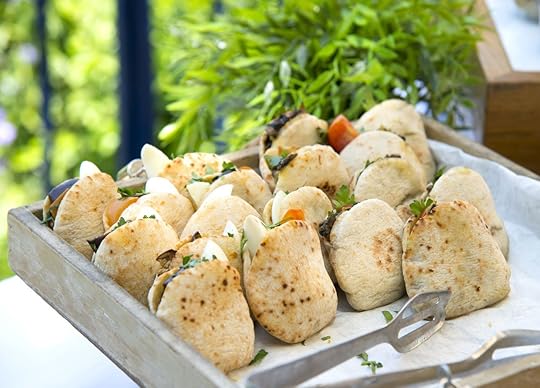
Photo: hadasit/Shutterstock
This pita sandwich is easy to eat on the go, and it’s a classic Israeli food eaten for lunch or as a snack. It’s made with fried eggplant, pickles, potatoes, parsley, hummus, Israeli salad, and tahini. It also commonly incorporates hard-boiled eggs, which can be removed for vegans. All of the ingredients are then stuffed into a pita to make a sandwich.
The sabich is believed to have been created by Iraqi immigrants who owned a small food stall in Ramat Gan. It’s the perfect example of how wrapping your favorite foods in pita is sometimes the best way to enjoy everything all at once.
5. Shakshuka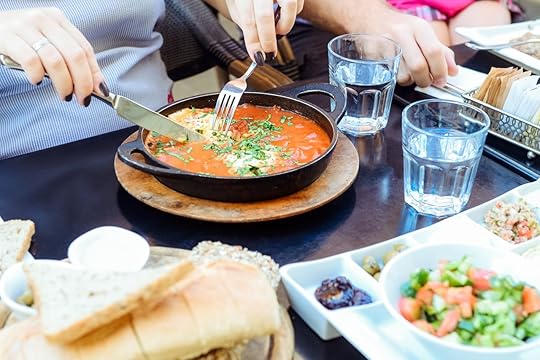
Photo: Okrasiuk/Shutterstock
If there’s one dish that can rival falafel when it comes to classic Israeli food, Sala Levin writes in Moment, it’s shakshuka. Shakshuka is made with tomatoes, peppers, chickpeas, onions, garlic, and cumin. Shakshuka is usually topped with eggs, but can be left out to make the dish vegan. All of the ingredients are stewed together and served alongside bread or pita.
Shakshuka originally comes from North Africa. People in the Ottoman Empire, which spanned from Eastern Europe through the Middle East and North Africa at its peak, had a stew called saksuka made with vegetables and meat. North African Jews took the meat out, Levin writes, to make the dish pareve. Today, there are variations that incorporate a myriad of different spices and vegetables, depending on the preferences of the cook. 
The post 5 fresh and flavorful vegan dishes from Israel appeared first on Matador Network.

Airbnb’s coolest houses in all 50

We hope you love the spaces and stays we recommend! Just so you know, Matador may collect a small commission from the links on this page if you decide to book a stay, and listed prices are accurate as of time of publication.
A new year means it’s time to optimistically look forward to the travel opportunities ahead of you, and not dwell on the ones that fell by the wayside in 2020. To help give you some inspiration, Airbnb has identified a list of properties that are most frequently “wish listed” by Airbnb users. From an Alaskan log cabin to a Hawaiian treehouse to a Pirates of the Caribbean-themed hideout in California, these Airbnbs will stoke your travel fire and maybe even motivate you to book a long overdue trip. Airbnb conducted a survey that found more than a third of Americans daydream about travel daily, and more than two thirds say daydreaming about travel brings positive emotions. Even more euphoric than daydreaming, however, is actually clicking that “book” button. These are Airbnb’s most wish-listed stays in all 50 states.
Alabama — Storybook Castle BnB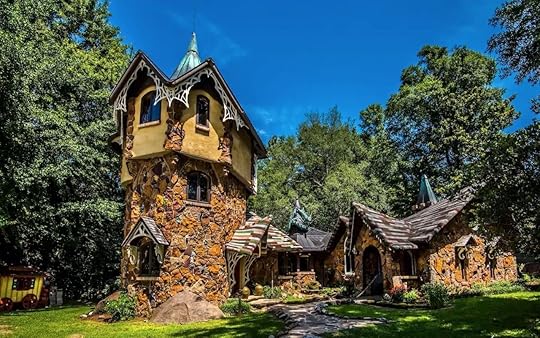
Photo: Airbnb
Sheldon Castle is a historic, secluded home in Fairhope, AL. Guests will stay in the studio suite, a private part of the castle with vaulted ceilings, exposed beams, kitchenette, and a spacious feel.
Alaska — Cozy Alaskan Log Cabin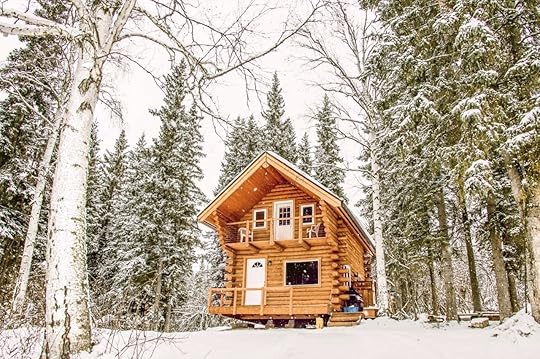
Photo: Airbnb
When you imagine an authentic Alaskan experience, you probably picture something like this cabin. The log cabin overlooks Creamer’s Field Waterfowl Refuge on the edge of the woods, with trails and wildlife viewing that make it perfect for outdoors and nature lovers.
Arizona — Experience Hogan by the River, Navajo Hogan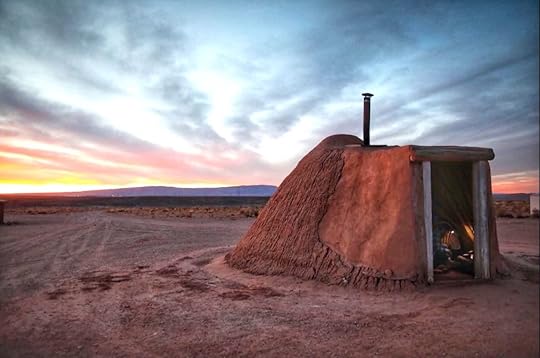
Photo: Airbnb
This off-the-grid home is located in a secluded part of Western Navajo Nation. It’s close to iconic natural wonders like Monument Valley and the Grand Canyon.
Arkansas — 87Getaway Treehouse Escape
Photo: Airbnb
This treehouse sits in the middle of the Ozark Forest. You’ll be surrounded by trees while living in comfort, enjoying the luxuries of the treehouse’s jacuzzi, hammock, and fire pit.
California — Pirates of the Caribbean Getaway
Photo: Airbnb
It’s as close to being on the movie set as you’ll probably get. This one-room guesthouse has waterfalls, ponds, and a tropical theme that creates the illusion you’re on a pirate ship in the Caribbean.
Colorado — Rocky Mountain Treehouse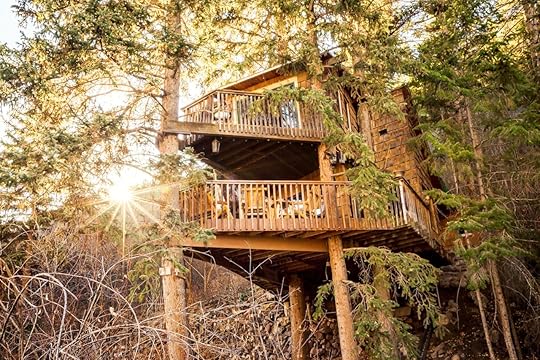
Photo: Airbnb
Built in 1971, this treehouse sits on two acres of land with a creek running underneath it. It’s attached to 4,100-foot-tall spruce trees with a winding rock staircase, and includes a wood burning stove, full kitchen, bathroom with a rock shower, and a private balcony.
Connecticut — Geodesic Dome in the Woods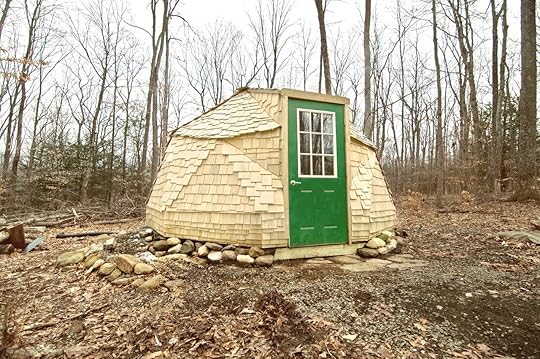
Photo: Airbnb
This dome is for those who truly want to get away from civilization. Located on the edge of the woods, this 165-square-foot dome has no power or heat, but there’s a wood fire pit and nearby organic farm to help you reconnect with nature.
Delaware — First Tiny Home in the First State
Photo: Airbnb
Situated on three acres of private property, this tiny home has a fire pit, grill, and cozy living space. It’s perfectly located for exploring coastal Delaware.
Florida — Treehouse at Danville
Photo: Airbnb
This modern treehouse yurt in Danville is equipped with a tree trunk elevator, private shower, and air conditioning, so you won’t exactly be roughing it. The accommodation is surrounded by oak and magnolia trees, with a panoramic window and four-foot skylight for spectacular views.
Georgia — Secluded Intown Treehouse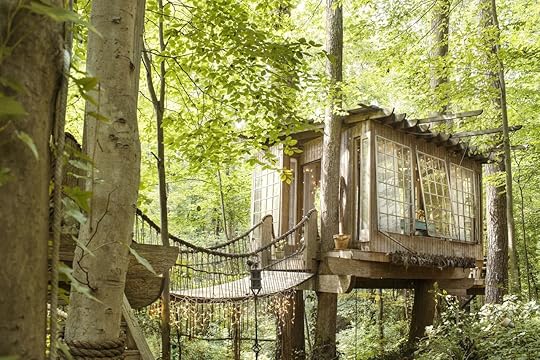
Photo: Airbnb
This treehouse is composed of three furnished rooms in the treetops, and surprisingly, it’s located right in downtown Atlanta. Despite the urban setting, its rooms are inspired by themes of “Mind, Body, and Spirit,” and designed to help guests relax and decompress.
Hawaii — The Kukui Treehouse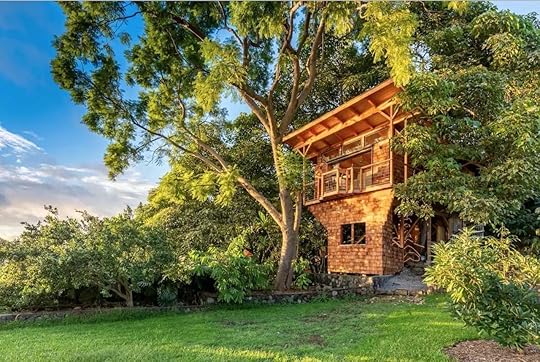
Photo: Airbnb
This 500-square-foot treehouse on the Big Island of Hawaii is a handcrafted, rustic experience high above the ground. Trees grow through the center of the property, which has incredible views of the ocean and the lush three-acre property.
Idaho — Big Idaho Potato Hotel
Photo: Airbnb
This property takes Idaho’s association with potatoes to the next level. This six-ton potato home has traveled the country, and now it rests permanently on 400 acres of Idaho farmland south of downtown Boise.
Illinois — Ryan’s Place Cabin
Photo: Airbnb
This cabin has been restored to look exactly as it did in 1865. Surrounded by a rural setting with an abundance of farm animals, the cabin is the perfect place to unwind and relax.
Indiana — Birdsong
Photo: Airbnb
Birdsong is a renovated 20th-century barn, with Edison lighting, fully-stocked kitchen, spiral staircase, bedroom loft, and fire pit. The property is part of 16 acres of land full of wildlife, including turkeys and deer.
Iowa — Rural Coon Rapids Cabin w/ Deck
Photo: Airbnb
This secluded log cabin is surrounded by Whiterock Conservancy’s wilderness, making it the perfect location for outdoors enthusiasts. The rustic house is also just six miles from the town of Coon Rapids.
Kansas — Cozy Cabin Retreat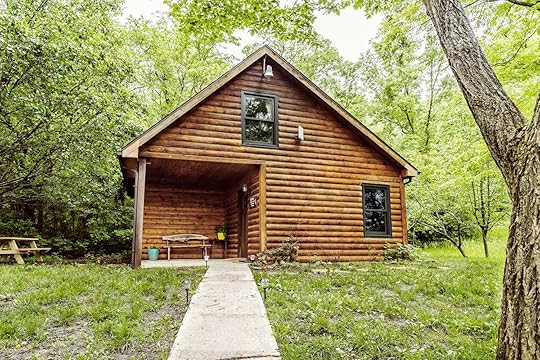
Photo: Airbnb
This renovated cabin on 15 acres of woodland will allow you to escape for a much-needed nature getaway. The property has hiking trails, a labyrinth, and even an axe throwing setup.
Kentucky — Eagles Nest Treehouse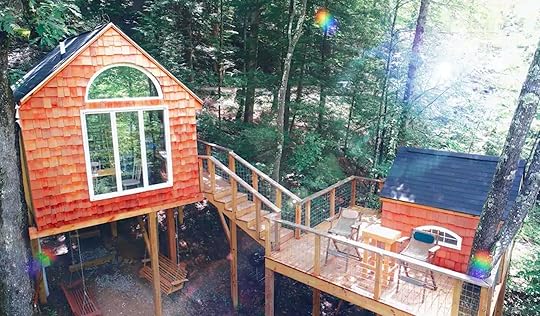
Photo: Airbnb
This treehouse has spectacular views of the mountains, and a “nest” deck overlooking the forest. There are also hiking trails through the forest so you can actually get out there and experience nature up close.
Louisiana — Historic Engine 24 New Orleans Firehouse
Photo: Airbnb
It’s not just a gimmick — this 19th century property is actually a renovated firehouse in New Orleans’ historic French Quarter. Despite its origins, the property is equipped with modern amenities for a comfortable stay.
Maine — The Canopy Treehouse, a Luxury Carbon Free Retreat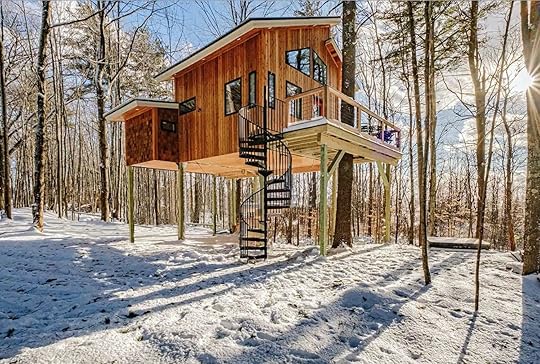
Photo: Airbnb
This small, 350-square-foot treehouse is fully equipped with a refrigerator, microwave, stove, a loft for sleeping, and a deck with a grill. This peaceful eco-luxury retreat gives you a weekend getaway with a smaller environmental footprint.
Maryland — Cove Point Lighthouse Keeper’s House
Photo: Airbnb
Lighthouses are the quintessential waterfront accommodation, and this lighthouse, dating back to1828, is no exception. It’s the oldest continuously operating lighthouse in Maryland, so your ocean views also come with a dose of history.
Massachusetts — The Pondhouse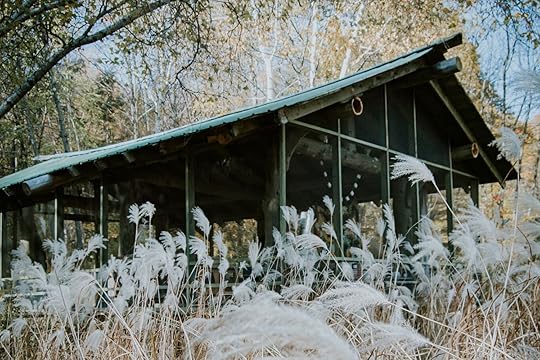
Photo: Airbnb
If you’ve always longed for your own Thoreau-esque Walden Pond experience, this is probably as close as you’ll get. This rustic pond house in Ashfield has a fire pit, outdoor hot shower, outdoor sink, and composting toilet. Note that there is no kitchen, Wi-Fi, or cell service, and instead of walls you’ll find screens, so you’ll truly be roughing it.
Michigan — Fernside A-Frame: Private River Front
Photo: Airbnb
On the banks of the Sturgeon River in Indian River, this A-Frame house is a blend of modern and classic, with an open-floor plan and floor-to-ceiling windows to keep the space bright.
Minnesota — NE MPLS Magic Studio @ the Wolf House
Photo: Airbnb
This unique house is painted all over with wolf-themed murals and covered with rocks to create a truly quirky, artsy environment. It’s located in the Minneapolis Arts District, close to restaurants, bars, and family-friendly activities.
Mississippi — Eco-Beach House in the Trees
Photo: Airbnb
This treehouse is perfect for birdwatchers and nature lovers. The garden below is full of birds and butterflies, and it’s just two blocks away from the beach.
Missouri — Forest Garden Yurts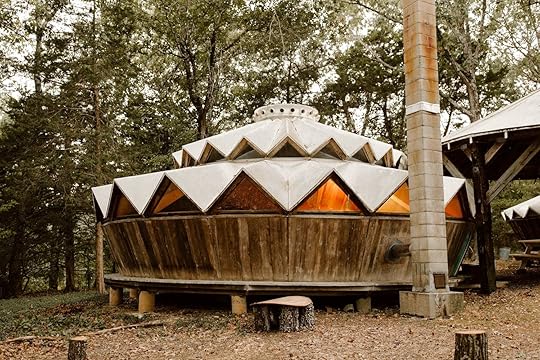
Photo: Airbnb
These glamping yurt-like structures are wooden accommodations designed and built in the 1970s on four acres in the Ozark Forest. They’re simple in design but impressive in their artistic detail.
Montana — Meadowlark Treehouse at Montana Treehouse Retreat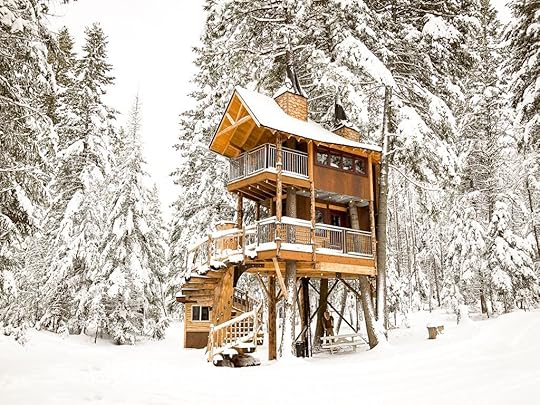
Photo: Airbnb
Located on five wooded acres, this two-story treehouse just 30 minutes from Glacier National Park is perfectly situated for experiencing Montana’s nature. It’s ideal for a writer’s retreat, honeymoon, or romantic getaway.
Nebraska — Lazy Oaks Glamping for 2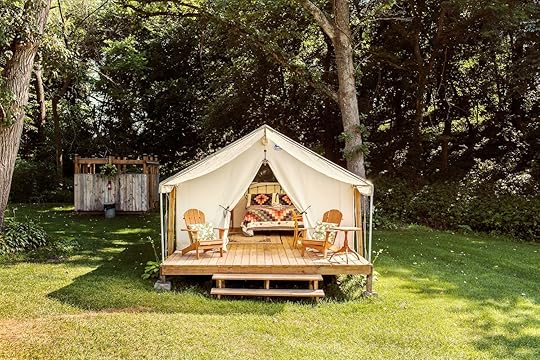
Photo: Airbnb
This glamping retreat is located on 11 acres of secluded land. You’ll be staying in a canvas tent on a raised deck, with a porch overlooking the vineyard and garden. The tent is furnished with antiques, a queen bed, and dresser.
Nevada — Tiny House Near Las Vegas
Photo: Airbnb
Just an hour south of Las Vegas, this tiny house is located on a dude ranch. As you might expect, you’ll be able to go horseback riding and participate in cattle drives and rodeo events.
New Hampshire — Tree House at the Shire
Photo: Airbnb
This rustic cabin in the woods is full of New England charm. This small, economical cabin is truly in the heart of the wilderness, but just 15-20 minutes from North Conway.
New Jersey — Cavalier Farm
Photo: Airbnb
This property might be a farm, but it’s as luxurious as a five-star hotel. With two wood fireplaces, a game room, library, and chef’s kitchen, you’ll have every imaginable comfort at your fingertips. It’s also close to several golf courses, a water park, swimming holes, the Appalachian Trail, and wineries and breweries.
New Mexico — Casita Don Gaspar
Photo: Airbnb
A guesthouse among pine trees, Casita Don Gaspar is a private and peaceful retreat with views of the surrounding greenery and mountains. The two-story, 900-square-foot house is also just 20 minutes away from downtown Santa Fe, for when you want a taste of city life.
New York — Willow Treehouse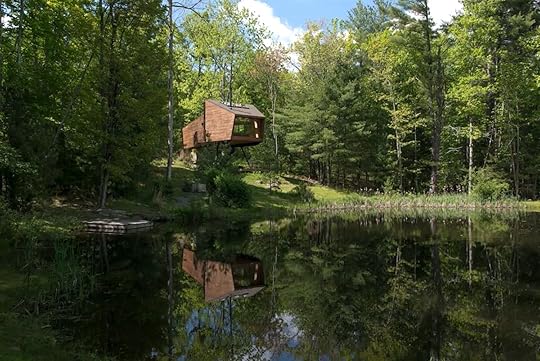
Photo: Airbnb
This fancy treehouse is the ideal country retreat in upstate New York. The cozy space overlooks a small pond on a wooded property, and when you’re not enjoying the view or swimming in the pond, you can explore nearby Woodstock.
North Carolina — Luxurious Secluded Romantic Treehouse with Hot Tub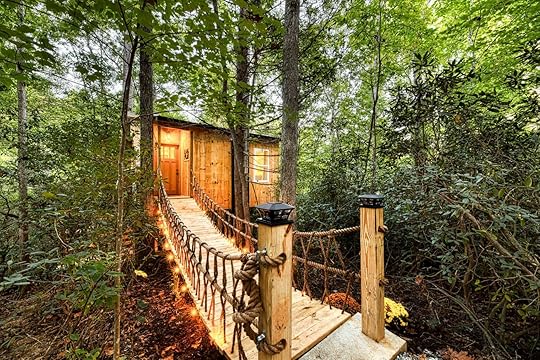
Photo: Airbnb
This woodland oasis has a swinging bridge for an entrance, making for a fun way in and out. The treehouse, with a deck and hot tub, overlooks the forest on 14 acres of land, and sits just 10 minutes from Black Mountain and 20 minutes from Asheville.
North Dakota — Lamppost 15
Photo: Airbnb
Located near shopping and the airport in Bismarck, Lamppost 15 is a fun, colorful place to stay on your next trip to North Dakota. Each room has unique elements, from barn doors to corrugated wainscotting, and colorful LED light strips throughout the house.
Ohio — Treehouse Village — The Box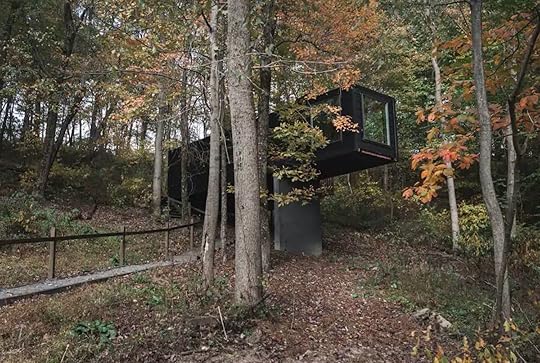
Photo: Airbnb
Compared to other treehouses, this one in Dundee has a distinctly modern feel. The Box is a converted shipping container that makes efficient use of space, with huge windows giving you a view of the treetops.
Oklahoma — Scenic Mountain Lodge on Sardis Lake
Photo: Airbnb
This three-story cabin with panoramic mountain and lake views is the perfect nature getaway. It has two outdoor decks and has access to the lake and hiking trails near the property.
Oregon — Majestree @ Out ‘n’ About Treehouse Treesort
Photo: Airbnb
This treehouse just outside Cave Junction can fit six to seven people, and is only a short drive away from the Oregon Caves National Monument, Redwood National Forest, and the Oregon coast. The treehouse is 47 feet off the ground and accessed by stairs and suspension bridges.
Pennsylvania — Secret Gateway Nestled in a Woodland Setting
Photo: Airbnb
When you arrive at this chalet you might think you’ve just stepped inside the pages of a fairy tale. This storybook-feel house is as cozy on the inside as it looks on the outside, with a wood stove, fireplace, and rustic pine floors.
Rhode Island — Farm on the Coast
Photo: Airbnb
Located between Newport and Narragansett, this bucolic farm was built in 1941 during World War II. Now it has a cozy guest suite for visitors, and there’s no television so you won’t be tempted away from the area’s relaxing beaches or nearby islands.
South Carolina — A Pirate’s Life For Me: Houseboat Downtown w/ Bikes
Photo: Airbnb
This houseboat has a vaulted ceiling, captain’s quarters (bedroom), and sleeps three comfortably. It was featured on Tiny House Hunters and is called “Charleston’s Best Airbnb Experience.”
South Dakota — Cabin at Green Mountain
Photo: Airbnb
Located near the tiny mountain town of Nemo, in the valley of Boxelder Creek, this cabin is straight out of a Western movie. The 1910s building has a cathedral ceiling, a field-stone fireplace, and three sleeping areas, and is just a short drive away from Rapid City, Hill City, Sturgis, and Deadwood.
Tennessee — Dreamy Tiny House Cottage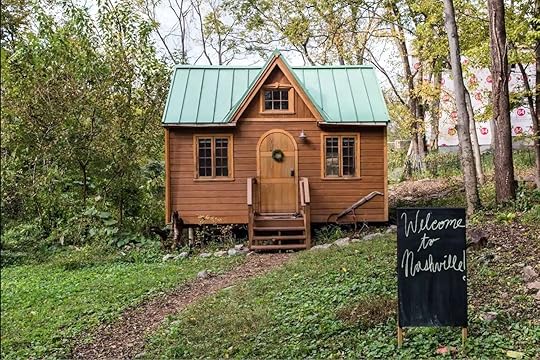
Photo: Airbnb
This tiny house was hand-built by the owners, and is the perfect work-from-home space in a magical setting. The property was featured in Southern Living, House Beautiful, and USA Today.
Texas — Escape the City to The Extraordinary Treehouse
Photo: Airbnb
A mix of modern and rustic, this handcrafted treehouse is located in a secluded area surrounded by Japanese maples and next to a running brook. You’ll enjoy the winding gravel footpaths, a forested canopy, and the rugged nature of Little Forest Hills.
Utah — Dreamy Treehouse Above Park City
Photo: Airbnb
Located in a 200-year-old fir tree, this treehouse sits at an elevation of 8,000 feet in Park City, and it’s only accessible by 4×4/AWD down three miles of dirt or snow-packed roads. It has a lofted bedroom with a skylight, 180-degree glass windows, and a deck with great nature views. When you’re not cozying up in the treehouse, you’ll be able to enjoy some of the best ski slopes in Utah.
Vermont — Tanglebloom Cabin | Glamping Nature Experience
Photo: Airbnb
The Tanglebloom Cabin sits in a forested grove on a flower farm, completely surrounded by nature. You’ll also be close to Stratton Mountain Resort for skiing, trails for hiking, and water for swimming and kayaking.
Virginia — Dream Rock Silo
Photo: Airbnb
This unique accommodation is a converted 1950s dairy barn and silo. Upon arrival, the hosts have a special game prepared for guests where they give you clues to a secret compartment in the silo. When you discover it, there’s a special gift for you to take home.
Washington — Underground Hygge
Photo: Airbnb
Fans of Middle Earth need look no further. This accommodation in the Columbia River Gorge is defined by its hobbit-hole doorways and cozy interior that will make you feel like you’ve just stepped into The Lord of the Rings.
Washington, DC — Gorgeous, Large, Modern 1 BR on Hist. Logan Circle
Photo: Airbnb
Built in 1900, this historic brownstone has a bright, colorful vibe, with in-ceiling lighting, stainless steel appliances, and bamboo flooring. It’s also ideally located in Logan Circle, one of DC’s hippest areas, so there’s no shortage of things to do within walking distance.
West Virginia — Custom Built Tiny House on 23 Acres of Forest
Photo: Airbnb
This custom-built tiny house is located on 23 acres of private forest, right next to the Lost River State Park. Swimming and boating are also available at nearby Trout Pond, and the state park just three miles away has tons of hiking trails, picnic areas, and a playground.
Wisconsin — Off-Grid Inn — Unit 1
Photo: Airbnb
A perfect retreat for couples, individuals, or groups, this cabin is designed as an off-grid escape into the forests of Wisconsin. There’s also a fire pit outside so you can enjoy the outdoor space even in the winter.
Wyoming — Heart Mountain Japanese Cabin
Photo: Airbnb
Located on a 4,000-acre certified organic farm, this cabin is influenced by traditional Japanese design. It has access to hiking trails for when you feel like exploring, and a dry sauna and large, elliptical bathtub for when you’d rather stay in and relax. 
The post Airbnb’s most wish-listed properties in all 50 states appeared first on Matador Network.

Scotland’s ‘Coo Cam’ Highland cows

Highland cows are one of Scotland’s most well-known peculiarities and have become tourist magnets, but given the pandemic travel restrictions, it’s just about impossible for travelers to see them these days. That’s why Visit Scotland launched the “Coo Cam,” making it easier for you to catch a glimpse of the country’s beloved cows without actually going there yourself.
The cam features cows from Kitchen Coos and Ewes in Dumfries and Galloway, and Swanston Farm in Edinburgh. The cows were filmed throughout November going about their daily lives, and videos will be released periodically this year on Visit Scotland’s social media platforms.
According to Visit Scotland, “While many countries, including Scotland, are in lockdown due to COVID-19 with travel restrictions in place, we want people to still be able to enjoy our country and what makes us unique through the virtual experiences you can still enjoy from the comfort of your own home. From using a tree as a scratch post, making their moos heard and having a good nosey at the camera, the Coo Cam provides an access all areas perspective to life on the farm.”
The footage was taken by professionals who care for the Highland cattle on a daily basis. Typically, visitors are encouraged not to approach cows during their visit to Scotland, and instead admire them from afar. So really, this is pretty much the same thing — just from really, really far away. 
The post Scotland’s Highland cows are now the stars of their own cam show appeared first on Matador Network.

TSA dog calendar is out

You might not be frequenting airports as much as you used to, which means not seeing those adorable security dogs quite as often. Luckily, the Transportation Security Administration (TSA) is bringing those dogs right into your home with this new 2021 canine calendar. The TSA released the calendar this month, featuring some of the cutest airport working dogs.

Photo: TSA
Not only does the calendar include 12 cute pictures, but also information and fun facts about each dog so everyone can get to know them better. Rony, the January puppy, for example, is a vizsla who works at Chicago Midway Airport with his handler John. The calendar says, “Rony has a lot of favorite treats. He thinks that anything edible is fair game! Rony has his sights on being President one day. He already knows how to command a room and is ready to make that leap after retirement”

Photo: TSA
Hunter, the April dog, is a German short-haired pointer at Los Angeles International Airport who ”truly enjoys going to work and loves his job of keeping the skies safe” and “lives for his Nylabone and large squeaky tennis balls.”
The calendar is completely free, and available on TSA’s website. All you have to do is click the calendar link, download it right to your desktop, and print it out. 
The post TSA released its 2021 dog calendar and it’s as cute as you think appeared first on Matador Network.

Positive sustainability news

This is The Climate Win, the most positive sustainability news around the world every week.
Ride hailing often gets a bad rap from environmentalists. Some of it is deserved, including its impact on public transit ridership. Studies including one from the University of Kentucky have shown that Uber and Lyft pull large numbers of riders from public buses and trains in major cities. And after a driver completes a ride, they can find themselves driving aimlessly until another fare comes in.
But major players including Uber and Lyft have been making efforts to green their operations. Lyft announced last year that it would switch its entire fleet to electric vehicles within ten years and hopefully sooner. And just this week, Uber announced plans to expand its “Uber Green” service, which gives riders the chance to opt for a ride in an electric vehicle rather than a gas powered one, to an additional 1,400 cities this year.
On tap for the company’s greener ride shares are major cities like New York, Miami, and Houston, as well as mid-sized and smaller cities across the country. And, Canada is getting green rides too, in major hubs including Winnipeg and Calgary. The EV option will be included in Uber’s membership program, Uber Pass, so riders can even rack up rewards points while taking a green ride.
“It’s our responsibility as the largest mobility platform in the world to reduce emissions and help drive a green recovery in our cities,” said Andrew Macdonald, Uber’s senior vice president of mobility and business operations, in a blog post. “We’re excited to kick off 2021 with more actions to increase clean mobility options for riders, drivers and cities.”
The company also rolled out plans to help its drivers transition to electric vehicles. Uber has teamed up with Avis to offer its drivers EV rentals, a program which will kick off in Los Angeles, before expanding to other cities. In San Francisco, drivers can swap out a drained battery for a charged one, thanks to the company’s partnership with Ample, an SF-based producer of smart batteries for electric vehicles.
“Starting this month, drivers in San Francisco can rent a vehicle with Ample technology and quickly swap their electric vehicle batteries in mere minutes, then return to the road fully charged,” Macdonald said in the blog post.
And the company plans to help its drivers charge their cars for less through a partnership with EVgo, which will be available at more than 800 charging stations around the country this year.
To be sure, Uber still has a long way to go before its entire fleet is electric, and that’s on top of addressing the issue with keeping people off public transit. However, the company plans to expand its Journey Planning service to additional cities worldwide this year, helping its riders pair Uber rides with public transit for an efficient, smooth move about their city.
This is where you come in. As the rider, you can step up to complement Uber’s efforts by choosing the EV option, when available, and using Uber in conjunction with public transit, cycling, and other modes of “zero added emissions” transit.
More climate winsPresident Donald Trump’s attempt to open the Arctic National Wildlife Refuge to oil and gas exploration appears to be a complete bust, according to Alaska Public Media. What the administration had hoped would lure lucrative bids from major oil and gas companies drew only three, one of which was the state of Alaska itself and none of whom were major industry players anticipating to explore and drill in the long term. The sale was expected to attract $1.8 billion in revenue, and drew a mere $14 million. It looks as though drilling in the ANWR is a pipe dream, no pipeline required.
A new hotel concept from Soul Community Planet (SCP) donates money to community and environmental causes with every stay. By retrofitting dilapidated motel properties, SCP is eliminating blight while offering a more sustainable lodging option to its guests. Additionally, the company uses sustainable toiletries, and follows a strict environmental code designed to minimize the environmental impact of the hotel itself and its guests. One of our staff at Matador .
A new group of citizen scientist activists called Climate Moms is out to combat climate change, beginning with education and awareness. The Wasington Post reported this week that the group will run ads both on television and online in what it says is the largest climate-related ad buy in the past decade. 
The post Uber to expand electric vehicle ride-sharing option to 1,400 cities appeared first on Matador Network.

January 14, 2021
Best cities for vegans

Vegan travelers know the struggle of finding food they can eat while traveling. In some destinations it can feel like an insurmountable task. A few cities, however, should be on the list of any vegan traveler who loves to eat as much as possible.
There are cities well known for promoting a vegan lifestyle around the globe. Restaurants and cafes hog the spotlight in many cases, but the following 10 cities follow a more encompassing vegan lifestyle with plant-based clothing stores and activities along with innovative meals. So brush up on how to order vegan in different languages and start planning.
1. Taipei, TaiwanCruelty-free dining is commonplace in Taiwan, and the capital city, Taipei, has a wide variety of vegan dining options. Vegan restaurants and supermarkets are easy to come by, as are vegetarian spots offering plenty of vegan options. It’s reputation is well known — PETA named Taipei “Asia’s most vegan friendly city” in 2016. Tofu crops up regularly in street food, and a local specialty is what’s called the Taiwanese Burrito, which consists of vegetables in a peanut sauce that are wrapped up burrito style. It’s worth visiting Ooh Cha Cha for raw vegan desserts. Taipei is so geared toward vegetarians and vegans that many of its hotels offer vegan breakfast and dinner options.
2. Ghent, Belgium
Photo: ANADMAN BVBA/Shutterstock
The city has wholeheartedly embraced the meat-free concept. There are even “Thursday Veggie Day” on which the city encourages people to eat vegetarian for a day once a week. Local cafes and restaurants often offer extra vegetarian options on Thursdays. Ghent has a huge number of organic markets and vegetarian cafes, and the city’s tourism office created an extensive map of vegetarian places to eat. Although many of the spots are vegetarian rather than fully vegan, there are always plenty of dairy and egg-free options and a good range of vegan beers at the city’s bars. Long-standing favorites include organic lunch joint Avalon and the vegan buffet at Komkommertijd. The city places a big emphasis on organic, locally-sourced produce too.
3. Edinburgh, Scotlandas the UK’s most vegan-friendly city in 2015, Edinburgh has a wide variety of vegan spots along with cafes, bars, and restaurants that have a good selection of meat-and-dairy-free options. Popular food trucks offer baked potatoes topped with everything from chickpea curry to vegan bolognese. The Auld Hoose is a popular pub famous for its extensive range of veggie-friendly options, including mammoth portions of nachos made with vegan cheese. For upscale vegan dining, try David Bann, where sophisticated dishes come at surprisingly accessible prices. It’s vegetarian rather than all-vegan, but there are loads of vegan options on the menu.
4. Chennai, India
Photo: Jayakumar/Shutterstock
Chennai has become a destination city for vegan travelers, mainly for the diversity of vegan curries, dosas, thalis, sambhar, and chutneys. Chaat — a potato-based street food that can be found all over the city — is very often good to go for vegans, with options including spiced corn and aloo. Chennai was named PETA’s most vegan-friendly city in India in 2018 thanks to the vegan-centric places to eat and vegan clothing stores.
5. Brighton, UKBrighton is home to numerous cruelty-free eating and shopping establishments. There are several dedicated vegetarian and vegan bed and breakfasts, and Brighton’s vegan drinking-and-dining scene ranges from cute artsy cafes — many of which are located in the backstreets that make up the Laines — to fine dining establishments. Brighton even has the UK’s first plant-based vegan pizzaria in Purezza.
6. Chiang Mai, Thailand
Photo: Elena Stepanova/Shutterstock
Chiang Mai has earned a reputation as one of Thailand’s top destinations for meat-free dining. In addition to the vegan buffets that can be found across Thailand, Chiang Mai has an ever-increasing number of upscale eateries, salad bars, organic-farm-to-table restaurants, and macrobiotic spots where the menus center on whole grains and vegetables. Highlights include Pun Pun, which has two restaurants and a vegan store in the city, all of which specialize in inventive, organic, and locally-sourced food, coffees, and smoothies. The mushroom-based version of the ubiquitous fermented Thai sausage is a thing of real joy.
7. Rio de Janeiro, BrazilRio’s dedicated vegan joints — such as Leblon institution Vegetariano Social Clube and downtown lunch stalwarts Green, and VegeCoop — have seen their plant-based ranks swell in recent years. Not to mention the juice bars on virtually every street corner that have been offering veg concoctions since way before juicing was a popular thing. Many of the salad bars in Rio charge by weight and are a joy, filled with olives, hearts of palm, fish-free sushi, and colorful bean salads. Furthermore, Rio’s best churrascarias (all-you-can-eat meat grills) are dream dinner spots for vegans. Diners can make unlimited visits to buffets groaning under the weight of meat-free sides, salads, and sushi. Some steakhouses offer discounted prices for those who won’t be partaking of the meaty main attraction, all you have to do is ask.
8. Berlin, Germany
Photo: Elena Stepanova/Shutterstock
Berlin is one of the world’s top vegan cities, according to the vegan and vegetarian restaurant site Happy Cow. It seems like a host of Berlin’s creativity has been poured into the vegan dining scene. Even the most hardened of carnivores may be swayed from their schnitzel and currywurst. The city hosts Europe’s largest vegan-vegetarian festival and is home to the world’s first vegan supermarket chain, Veganz. There are sophisticated venues for vegans dotted around town, along with countless vegan and vegetarian cafes and food trucks.
9. Portland, OregonPortland is one of the best US cities for vegans, but also one of the best in the world. Bye and Bye is a bar with an all-vegan menu that offers everything from edamame bowls and hummus to barbecue tofu and veggie platters, as well as cashew cheese and salad baguettes, and spaghetti with vegan meatballs and almond “parmesan.” But you don’t need to go to an all-vegan eatery to chow down on animal-free delights in PDX. Most restaurants, coffee shops, and bars offer a good range of vegan options to go with the craft beers and fair-trade coffees. Portland even lays claim to the world’s first vegan strip bar — Casa Diablo — should you be so inclined.
10. Vancouver, Canada
Photo: Russ Heinl/Shutterstock
Vancouver is home to vegan shoe stores, bakeries, food trucks, brunch joints, raw food bars, and supper clubs. The Acorn is rated among the best restaurants in Canada and, though it’s vegetarian rather than vegan, there are plenty of options here for strict vegos, and the slick decor makes it a good option for a special occasion meal. Heirloom is a long-standing favorite on the meat-free scene, with some good vegan wines as well as hearty brunches. Tacos, veggie burgers, and Asian-accented “chicken” burgers are among the highlights of Vancouver’s famously veggie-friendly food truck scene. 
A version of this article was previously published on March 27, 2016, and was updated on January 13, 2021, with more information.
More like thisVegetarianThe 10 best cities in the US for vegans and vegetarians in 2021The post The 10 most vegan-friendly cities in the world appeared first on Matador Network.

Hiking permit for Arizona's The Wave

The Wave, one of Arizona’s most stunning and popular geographic features, will soon be welcoming more visitors. The colorful sandstone rock formation in Vermilion Cliffs National Monument was formed by wind erosion and now resembles a smooth ocean wave. To protect the area’s integrity, the Bureau of Land Management (BLM) has capped the number of daily permits at 20, but now that number will be increased to 64.
The permits are in high demand. In 2018 over 200,000 people applied for just 7,300 available permits to take the hike through the Coyote Buttes North section of the park. Only 3.6 percent of applicants actually succeeded in securing a permit, however. Now that percentage is likely to go up.
Half of the permits can be reserved online four months in advance through an online lottery that costs $9 per application. The other half are given to the visitors’ center in Kanab on a first-come, first-served basis for $7 per person (and $7 per dog).
According to BLM Arizona State Director Ray Suazo, “We conducted robust environmental analysis and worked in collaboration with partners and interested stakeholders in an effort to allow more visitors access to the Wave, while maintaining wilderness character.”
Despite assurances, however, concerns remain about the effect more tourism will have on the integrity of the landscape. 
The post Arizona’s ‘The Wave’ will start allowing more daily visitors appeared first on Matador Network.

Matador Network's Blog
- Matador Network's profile
- 6 followers



